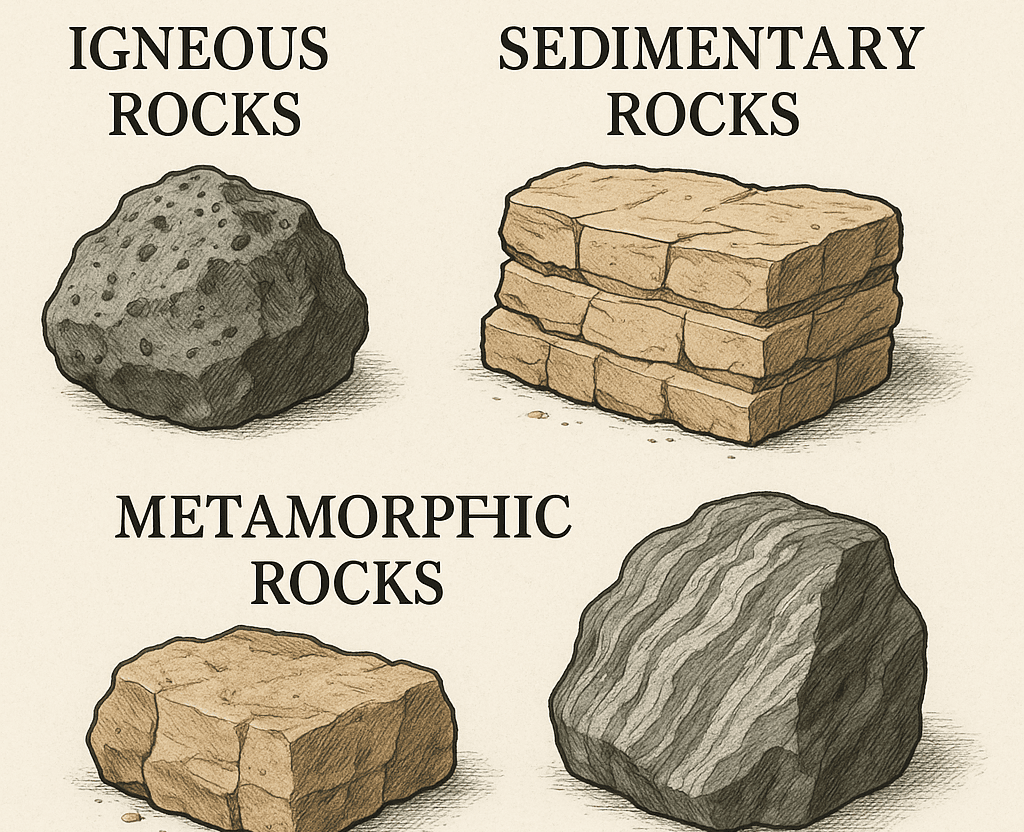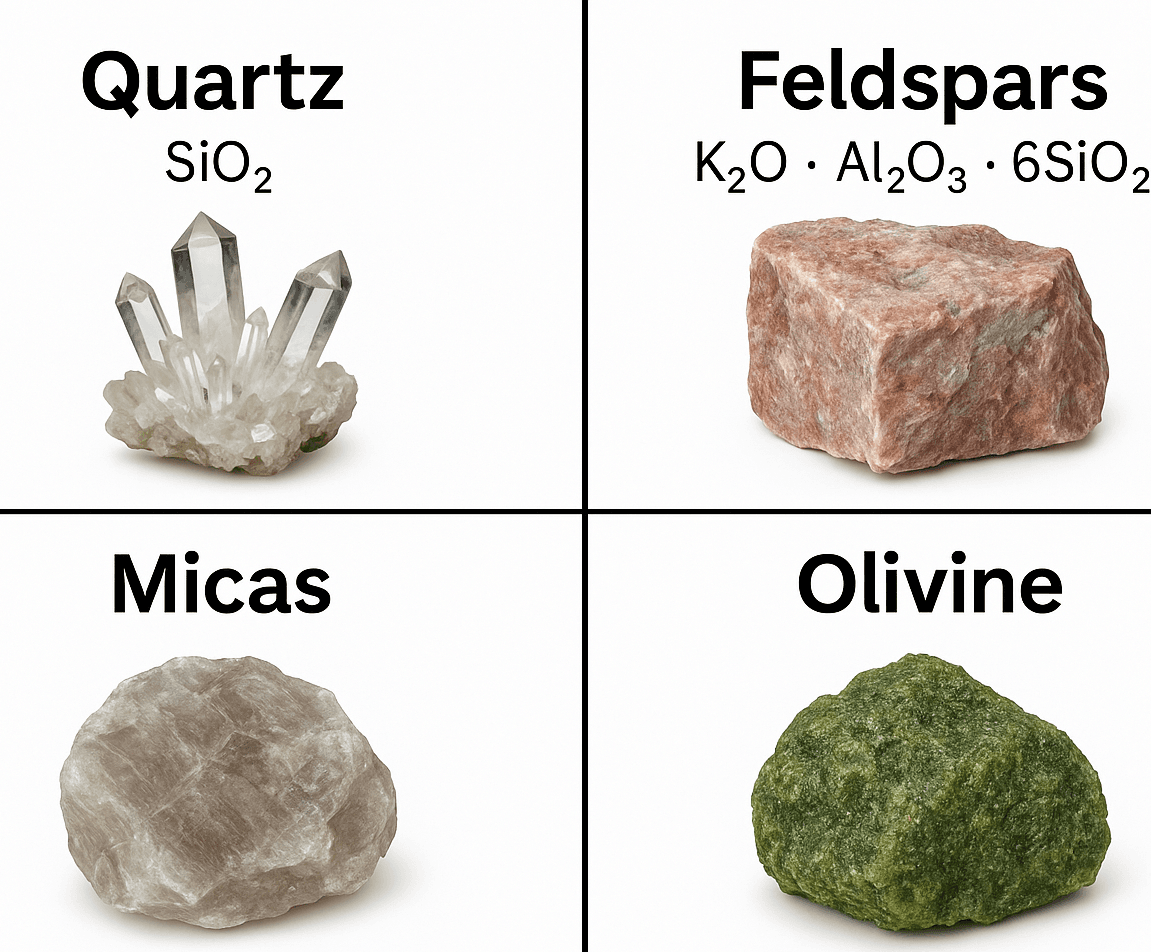Origin of Soil; Word Origin: Derived from Latin word ‘Solum’ meaning “floor”.
Definition of Soil; A dynamic natural body composed of minerals, organic materials, living organisms, air, and water, in which plants grow.
Branches of Soil Science
a) Edaphology
- Study of: Soil in relation to plant growth, nutrition, and crop yield.
- Word origin: Greek
- Edaphos = Soil
- Logos = Discourse
- Viewpoint: Soil is a natural medium for plant growth.
b) Pedology
- Study of: Origin, classification, and formation of soils.
- Word origin: Greek
- Pedon = Soil
- Logos = Study
- Father of Pedology: V.V. Dokuchaiev
- Viewpoint: Soil is a natural body.

Classification of Rocks Based on Mode of Formation
Rocks are classified into three major types:
- Igneous Rocks
- Formed by the cooling and solidification of molten magma or lava.
Examples: Granite, Basalt, Diorite, Gabbro, Syenite, - Types of Igneous Rocks:
- Plutonic (Intrusive): Formed inside the Earth; cooling is slow → large crystals.Examples: Granite, Gabbro, Diorite, Syenite
- Volcanic (Extrusive): Formed on the Earth’s surface; rapid cooling → glassy structure. Examples: Basalt, Andesite, Trachyte
- Note: Basalt is widely found in the Deccan Trap region of India.
- Sedimentary Rocks
- Derived from fragmentary materials of other rocks by deposition and consolidation of particles.
Formed by agents like water, wind, glacier, and gravity. - Examples: Limestone, Dolomite, Shale, Sandstone,
- Conglomerate Cover ~80% of Earth’s visible surface but only ~5% of the Earth’s volume.
- Metamorphic Rocks
Formed from igneous or sedimentary rocks by heat, pressure, or both, changing their texture and composition.
Examples & Origin:
- Gneiss (from Granite)
- Marble (from Limestone)
- Quartzite (from Sandstone)
- Slate (from Shale)
- Schist

Important Rock-Forming Minerals
Quartz (SiO₂)
- Most resistant to weathering
- Main component of acid rocks (e.g. granite)
- Gives rise to sandy soils
- Constitutes 36% of Earth’s crust
- Major component of sand fraction
- Acid rocks: Rich in free silica (e.g., granite)
- Basic rocks: Low in free silica (e.g., basalt)
Feldspars (K₂O·Al₂O₃·6SiO₂)
- ~48% of Earth’s crust
- Easily weathered → forms clay
- Potash Feldspar: Orthoclase (acid rocks)
- Plagioclase Group: Albite (Na), Anorthite (Ca)
Micas
- Micas (10% of Earth’s crust)
- Muscovite (White Mica): Potash-rich, more resistant
- Biotite (Black Mica): Magnesium-rich
- More resistant to weathering than feldspar
Olivine (FeMg)₂SiO₄
- Least resistant
- Weathers to serpentine and talc
Tourmaline; Source of boron, a micronutrient
Sources of Plant Nutrients in Rocks
|
Nutrient |
Mineral Source |
|
Nitrogen (N) |
Organic Matter |
|
Phosphorus (P) |
Apatite, Fe/Al Phosphate |
|
Potassium (K) |
Micas, Feldspar |
|
Magnesium (Mg) |
Dolomite, Olivine, Biotite |
|
Calcium (Ca) |
Calcite, Gypsum |
|
Boron (B) |
Tourmaline |
|
Copper (Cu) |
Chalcopyrite |
|
Zinc (Zn) |
Sphalerite |
|
Molybdenum (Mo) |
Olivine |
|
Sulphur (S) |
Gypsum, Pyrite |
|
Iron (Fe) |
Haematite, Magnetite |
Primary vs Secondary Minerals
- Primary Minerals (Coarse texture – sands, gravels): Examples: Quartz, Orthoclase, Mica, Hornblende, Augite, Olivine
- Secondary Minerals (Fine texture – clay, silt): Examples: Clay minerals, Goethite, Haematite, Calcite, Gypsum
Weathering Resistance of Minerals
|
Resistance Level |
Minerals |
|
Very High |
Quartz (most resistant) |
|
High |
Muscovite |
|
Moderate |
Orthoclase (Feldspar), Biotite |
|
Low (Easily Weathered) |
Augite, Hornblende, Olivine, Calcite (least) |
Classification of Rocks by Silica Content
|
Type |
Silica Content |
Examples |
|
Acid Rocks |
65–70% |
Granite, Sandstone, Rhyolite |
|
Basic Rocks |
40–55% |
Basalt, Gabbro, Diabase |
|
Intermediate Rocks |
55–65% |
Diorite, Andesite, Syenite |
Rock Formation Cycle
- Igneous rock (solidification of magma/lava)
- Weathering → Sediments
- Sedimentary rock (compaction & cementation)
- Heat & Pressure → Metamorphic rock
- Melting → Magma → Cycle repeats
What is Weathering?
Weathering is the natural breakdown of rocks at or near the Earth’s surface by physical, chemical, or biological processes.
Weathering ≠ Erosion (movement of weathered materials)
Key Concept: Rock ➝ Fragmentation ➝ Chemical alteration ➝ Organic addition ➝ Soil formation
Classification of Weathering; There are 3 types of weathering processes:
(A) Physical or Mechanical Weathering
Breakdown of rocks without any chemical change. Dominant in arid, cold, and mountainous regions.
➡️ Leads to the formation of skeletal soils.
Agents of Physical Weathering:
- Heat and Cold: Differential expansion of minerals → peeling/flaking
- Freezing and Thawing: Water expands ~9% on freezing → force of ~150 tons/sq.ft.
- Glaciers: High grinding power (40 lb/in² per 100 ft of thickness)
- Streams & Rivers; Erosion power ∝ velocity⁶ → fine powder formation
- Waves & Ocean Currents: Cause chipping and pounding of rocks
- Wind with Sand Particles: Abrasive weathering common in deserts
(B) Chemical Weathering
Involves decomposition of minerals and formation of secondary products (e.g. clays, oxides).
Most active in:
- Humid tropical zones
- Warm & moist climates
Key Chemical Processes:
|
Process |
Reaction / Effect |
|
1. Solution |
CO₂ + H₂O → H₂CO₃ (Carbonic acid) dissolves rocks |
|
2. Carbonation |
CaCO₃ + H₂CO₃ → Ca(HCO₃)₂ (leached) → forms Kankar |
|
3. Oxidation |
Fe²⁺ → Fe³⁺ → Fe(OH)₃ (Red color) |
|
4. Reduction |
Fe₂O₃ + H₂ → FeO + H₂O (in water-logged soils) |
|
5. Hydration |
Fe₂O₃ + 3H₂O → 2Fe₂O₃·3H₂O (Limonite formation) |
|
6. Hydrolysis |
Feldspar + H₂O → Clay + KOH |
|
7. Deposition |
Fe/Al colloids coagulate in cementation zones |
(C) Biological Weathering: Involves both physical and chemical weathering by living organisms.
Biological Agents:
- Lichens & Mosses: Secrete acids that break minerals
- Plant Roots: Penetrate cracks, produce CO₂
- Microorganisms: Decompose organic matter and release acids
- Animals & Earthworms: Burrow, churn, and aerate the soil
“Biological weathering is essentially physical and chemical weathering caused by biological agencies” – Joffe
Soil Development & Water Movement
Water movement influences mineral horizon development:
- Humid Regions: Leaching → minerals move to lower layers
- Arid Regions: Capillary rise → salt accumulation
- Impermeable Subsoil: Lateral movement of water → accumulation on horizon
Weathering Susceptibility of Rocks
|
Rock Type |
Resistance to Weathering |
|
Basic Igneous Rocks (e.g. Basalt) |
Weather quickly |
|
Acid Igneous Rocks (e.g. Granite) |
More resistant |
|
Sedimentary Rocks (e.g. Sandstone) |
More resistant than igneous |
|
Limestone |
Less resistant |
Chemical Composition of Earth’s Crust
|
Element |
% Composition |
|
Oxygen (O) |
49.2% |
|
Silicon (Si) |
25.67% |
|
Aluminium (Al) |
7.5% |
|
Iron (Fe) |
4.71% |
|
Calcium (Ca) |
3.39% |
|
Magnesium (Mg) |
1.93% |
Exam Pointers
- Kankar nodules form by carbonation and are found in Red and Black soils of India.
- Physical weathering dominates in deserts and alpine regions → Skeletal soils.
- Hydration and hydrolysis are key in forming clay minerals.
- Reduction occurs in anaerobic (waterlogged) soils.
- Oxidation colors soil red (Fe³⁺ → Fe(OH)₃).

